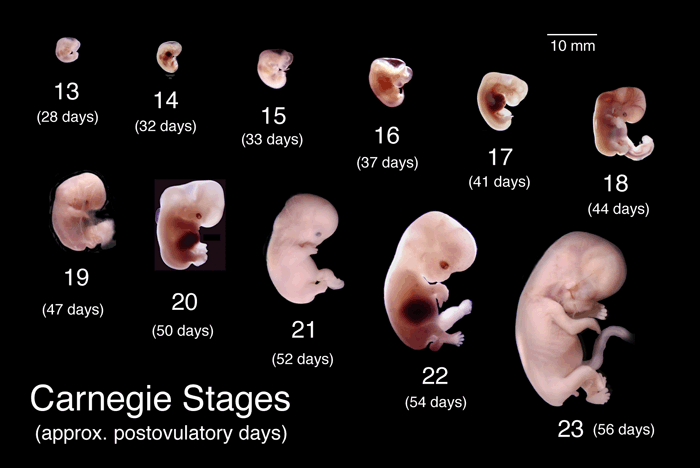Biology

- What Is Parthenocarpy?
A) Process of formation of seeds without fertilization.B) Mechanism of transfer of pollen grains from anther to stigma. C) Phenomenon of development of fruits without fertilization.D) Phenomenon of formation of more than one embryo in the seed. The...
- Blastocyst
Term: blastocystOrigin: Anc Greek ??????> blastos (=sprout, germ) >?????/valo(=push, throw) + ??????/istimi(=put)+ ??????/cystis(=pouch or anatomical sac eg bladder) > ???/kyo(=carry a baby in a sac) Definition The blastocyst is a embryonic...
- Comparison Between Embryo And Endosperm
Embryo and Endosperm: Major Differences Embryo Endosperm 1. It is formed by fertilized egg (syngamy) It is formed by fusion of secondary nucleus (triple fusion) 2. It is always...
- Amazing Facts About Human Reproductive System
Ø In a fetus, fingerprints are acquired at the age of 3 months (first trimester).Ø A foreskin (prepuce) from circumcised babies takes only 3 weeks to grow skin that can cover 3 basketball courts!! It can be used in treating burn patients.Ø ...
- Skin And Hair Facts
A lifespan of an eyelash is approximately 150 days.A Russian man who wore a beard during the time of Peter the Great had to pay a special tax.A survey done by Clairol 10 years ago came up with 46% of men stating that it was okay to color their hair. Now...
Biology
Changes occuring in embryo during pregnancy

| Days | Changes |
| 1 | Fertilization. Diameter of egg is about 0.15 mm |
| 2 | 2 cell stage |
| 3 | 16 cell stage (morula) |
| 4 | Entry of blastocyst in the lumen of uterus. Disappearance of zona pellucida. Diameter of blastocyst is about 0.3 mm |
| 7-8 | Partial entry of blastocyst inside endometrium; Implantation |
| 12 | Complete entry of blastocyst into endometrium. Extra-embryonic mesoderm, amnion and yolk sac |
| 14 | Primitive streak formation |
| 18 | Formation of 3-5 pairs of somites |
| 19 | Neural groove, neural plate, notochordal plate and 6-8 pairs of somites formed. |
| 24 | Indication of formation of head and tail region. 21-23 pairs of somites formed. Formation of heart continues at ventral side. |
| 28 | Heart starts beating. Neural tube is formed. Blood islands appear. 3 pairs of visceral arch and 30-31 pairs of somites formed. |
| 32 | 30-39 somites formed |
| 7 weeks | Jaws, fingers and external ears begin to appear. The C-R length (crown-rump length: the length from head to the bottom of hips) is 19-20 mm |
| 8 weeks | Embryo is completely surrounded by amnion. Fingers and toes clearly visible. Almost all organs formed with continuing development. At the end of 8th week the embryo appears like a little human (foetus). C-R length: 28-30 mm |
| 12 weeks (first trimester) | The major organs (limbs, external genital organs etc) are well developed. |
| 5 months | First movement of foetus and appearance of hair on the head. Blood formation starts in bone marrow. Decidua capsularis and parietalis connect together. |
| 24 weeks (second trimester) | Body is covered with fine hair, eyelids separate and eye lashes are formed. |
| 9 months | Placenta attains maximum size. Nails on finger appear. In the next 10 days the foetus is ready to born as a little baby. |
- What Is Parthenocarpy?
A) Process of formation of seeds without fertilization.B) Mechanism of transfer of pollen grains from anther to stigma. C) Phenomenon of development of fruits without fertilization.D) Phenomenon of formation of more than one embryo in the seed. The...
- Blastocyst
Term: blastocystOrigin: Anc Greek ??????> blastos (=sprout, germ) >?????/valo(=push, throw) + ??????/istimi(=put)+ ??????/cystis(=pouch or anatomical sac eg bladder) > ???/kyo(=carry a baby in a sac) Definition The blastocyst is a embryonic...
- Comparison Between Embryo And Endosperm
Embryo and Endosperm: Major Differences Embryo Endosperm 1. It is formed by fertilized egg (syngamy) It is formed by fusion of secondary nucleus (triple fusion) 2. It is always...
- Amazing Facts About Human Reproductive System
Ø In a fetus, fingerprints are acquired at the age of 3 months (first trimester).Ø A foreskin (prepuce) from circumcised babies takes only 3 weeks to grow skin that can cover 3 basketball courts!! It can be used in treating burn patients.Ø ...
- Skin And Hair Facts
A lifespan of an eyelash is approximately 150 days.A Russian man who wore a beard during the time of Peter the Great had to pay a special tax.A survey done by Clairol 10 years ago came up with 46% of men stating that it was okay to color their hair. Now...
